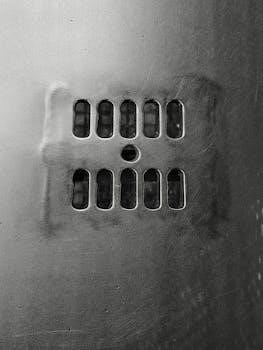Anatomy of Breast Lymphatic Drainage
The lymphatic system plays a vital role in immune function and fluid balance. Understanding its anatomy is key, especially regarding breast lymphatic drainage. The breast’s lymphatics have multiple pathways, often involving both superficial and deep systems, which are critical for understanding disease spread.
Overview of the Lymphatic System
The lymphatic system is a complex network of vessels, nodes, and glands that work in concert with the circulatory system. It’s crucial for immune response and maintaining fluid balance throughout the body. Lymphatic vessels transport lymph, a clear fluid containing white blood cells, which help fight infection. These vessels collect fluid from tissues and carry it through lymph nodes, acting as filters. Lymph nodes contain phagocytic cells that remove harmful substances. This process helps maintain tissue homeostasis, collecting proteins and fluids that may leak from the blood vessels. Disruptions of this system can lead to conditions like lymphedema, affecting fluid drainage. Understanding this intricate system is important, especially when considering breast health, as breast carcinomas often spread through lymphatic vessels.

Primary Drainage Pathways⁚ Axillary Nodes
The axillary lymph nodes serve as the primary drainage pathway for the breast, receiving the majority of its lymphatic flow. Typically, 75-90% of breast lymphatic drainage goes to these nodes located in the armpit. Lymphatic vessels from the breast converge towards the axilla, often collecting in a sentinel lymph node at the lateral border of the pectoralis major muscle. This sentinel node is the first node in the axillary chain to receive lymph from the breast, making it clinically significant in breast cancer staging. The axillary lymph nodes are divided into different surgical levels, which helps surgeons plan for treatment. Drainage to axillary nodes usually occurs along a subdermal plane. Understanding the axillary node anatomy is crucial for managing breast cancer.

Secondary Drainage Routes
While axillary nodes are primary, secondary routes exist. These include the internal mammary nodes along the breastbone and posterior intercostal nodes. These pathways are less common but still important in breast cancer metastasis and understanding lymphatic flow.
Internal Mammary (Parasternal) Nodes
The internal mammary, also known as parasternal, lymph nodes are a crucial secondary drainage pathway for the breast, located along the internal thoracic artery within the chest. These nodes primarily drain the medial quadrants of the breast, playing a significant role in lymphatic drainage patterns. Approximately 15-25% of breast lymphatic drainage passes through this system, making them clinically relevant, especially in cases of medial breast tumors. These nodes can be involved in metastatic spread, and understanding their function is vital for cancer staging and treatment planning. The internal mammary nodes drain into the bronchomediastinal trunks, which also drain structures of the chest. Lymphatic drainage from the medial breast may reach the groin via the epigastric routes. Lymphatic drainage may also cross the midline, potentially reaching contralateral axillary nodes.
Posterior Intercostal Nodes
Posterior intercostal nodes represent another, though less frequent, secondary drainage pathway for the breast, typically receiving lymphatic fluid from the deeper breast tissues. These nodes are situated along the intercostal arteries in the posterior aspect of the chest wall. They constitute a minor portion, approximately 5%, of the overall breast lymphatic drainage, yet their involvement is clinically significant, especially when other drainage routes are compromised or affected by disease. Lymphatic drainage through the posterior intercostal nodes can provide an alternate route for cancer cells to spread, highlighting the complexity of breast lymphatic pathways. These nodes are not as commonly assessed in standard lymph node dissections but are important to consider, particularly in patients with extensive disease or when standard drainage pathways are disrupted.

Clinical Significance
The lymphatic drainage of the breast is critical in understanding breast cancer metastasis. It is a key factor in staging and treatment planning, especially concerning the spread of cancerous cells to lymph nodes.
Role in Breast Cancer Metastasis
Breast cancer cells often spread through the lymphatic system, making it a primary route for metastasis. Cancer cells can travel through lymphatic vessels, reaching regional lymph nodes and potentially distant organs. The axillary lymph nodes are frequently the first site of metastasis due to their proximity and extensive lymphatic drainage from the breast. Understanding these pathways is crucial for staging cancer and determining treatment plans. Lymph node involvement is a significant prognostic factor in breast cancer. The presence and number of cancerous lymph nodes are considered when assessing the risk of recurrence and need for further therapies. The lymphatic system’s role in metastasis underscores the importance of sentinel lymph node biopsy. This helps in early detection and tailored approaches for managing the spread of the disease.
Sentinel Lymph Node Biopsy (SLNB)
Sentinel Lymph Node Biopsy (SLNB) is a crucial procedure in the management of breast cancer. It involves identifying and removing the first lymph node(s) that receive lymphatic drainage from the tumor, known as the sentinel nodes. This is done by injecting a tracer, usually a radioactive substance or blue dye, near the tumor site. If cancer cells are present in the sentinel node, it indicates the potential for cancer spread to other lymph nodes and possibly distant sites. SLNB allows for a more targeted approach, helping to avoid unnecessary removal of lymph nodes when not needed. It also minimizes the risk of lymphedema, a common complication of extensive axillary lymph node dissection. SLNB plays a critical role in staging breast cancer and guiding further treatment decisions.

Lymphatic Drainage Patterns
Breast lymphatic drainage exhibits variations, with pathways leading to axillary, internal mammary, and intercostal nodes. The subareolar plexus, also known as Sappey’s plexus, serves as a key collecting point before lymph flows to these regions.
Variations in Drainage Pathways
While the axillary route is the primary lymphatic drainage pathway for the breast, significant variations exist. Drainage patterns are not always predictable and can differ greatly between individuals, and also within the same person. Lymphatic flow can vary from any quadrant of the breast, making understanding these variations crucial for clinical practice. Some breast lymphatics drain directly to nodal basins, without passing through the subareolar plexus. Medial breast regions may drain towards the parasternal nodes, potentially extending inferiorly to the groin. Lymphatic drainage can also cross the midline, reaching contralateral axillary nodes. Such variations highlight the complex nature of breast lymphatic drainage, necessitating careful consideration during diagnosis and treatment planning. The understanding of these alternative pathways is crucial in the effective management of breast cancer.
Subareolar Plexus (Sappey’s Plexus)
The subareolar plexus, also known as Sappey’s plexus, is a network of lymphatic vessels located beneath the areola. This plexus serves as a collecting point for lymph originating from the breast lobules. From Sappey’s plexus, the lymph then drains through three main routes, often paralleling venous tributaries. While it has historically been considered a primary drainage pathway, studies show that much of the lymph from the breast flows directly to the nodal basins, without passing through it. This emphasizes that while the plexus is an important anatomical structure, it isn’t the only pathway for lymphatic drainage. The plexus is significant in understanding the initial stages of lymph drainage. Sappey’s description of the breast lymphatics highlighted its importance in drainage towards the axilla.


